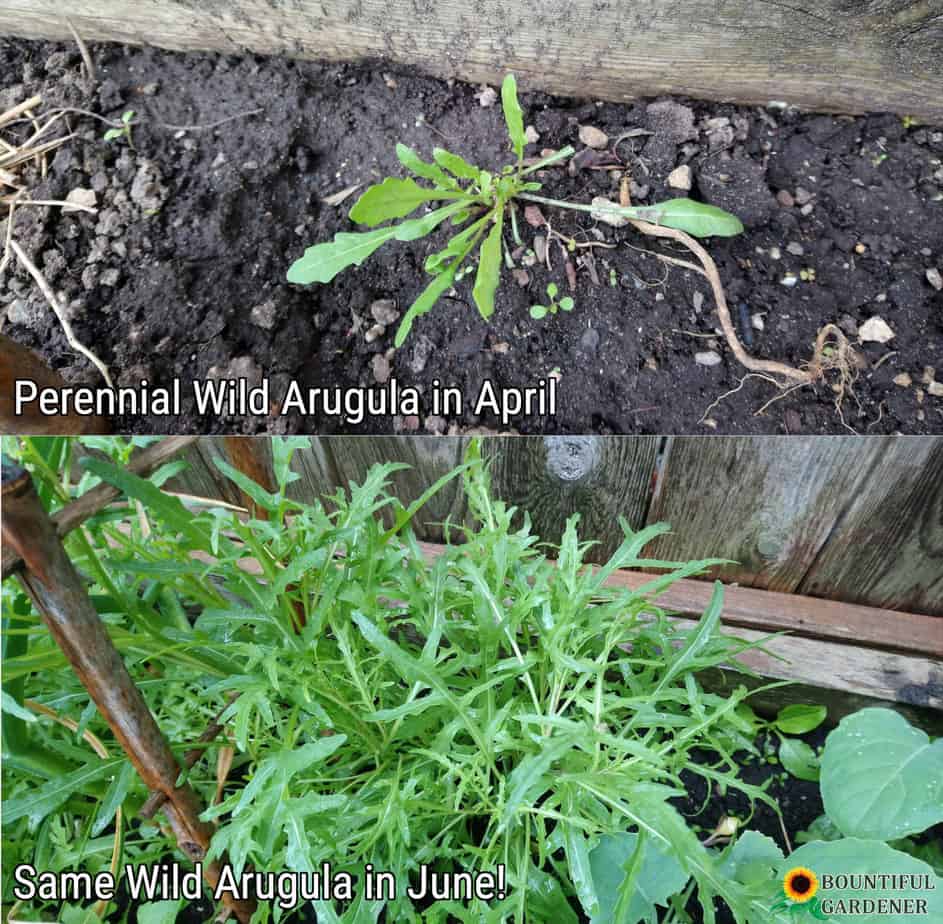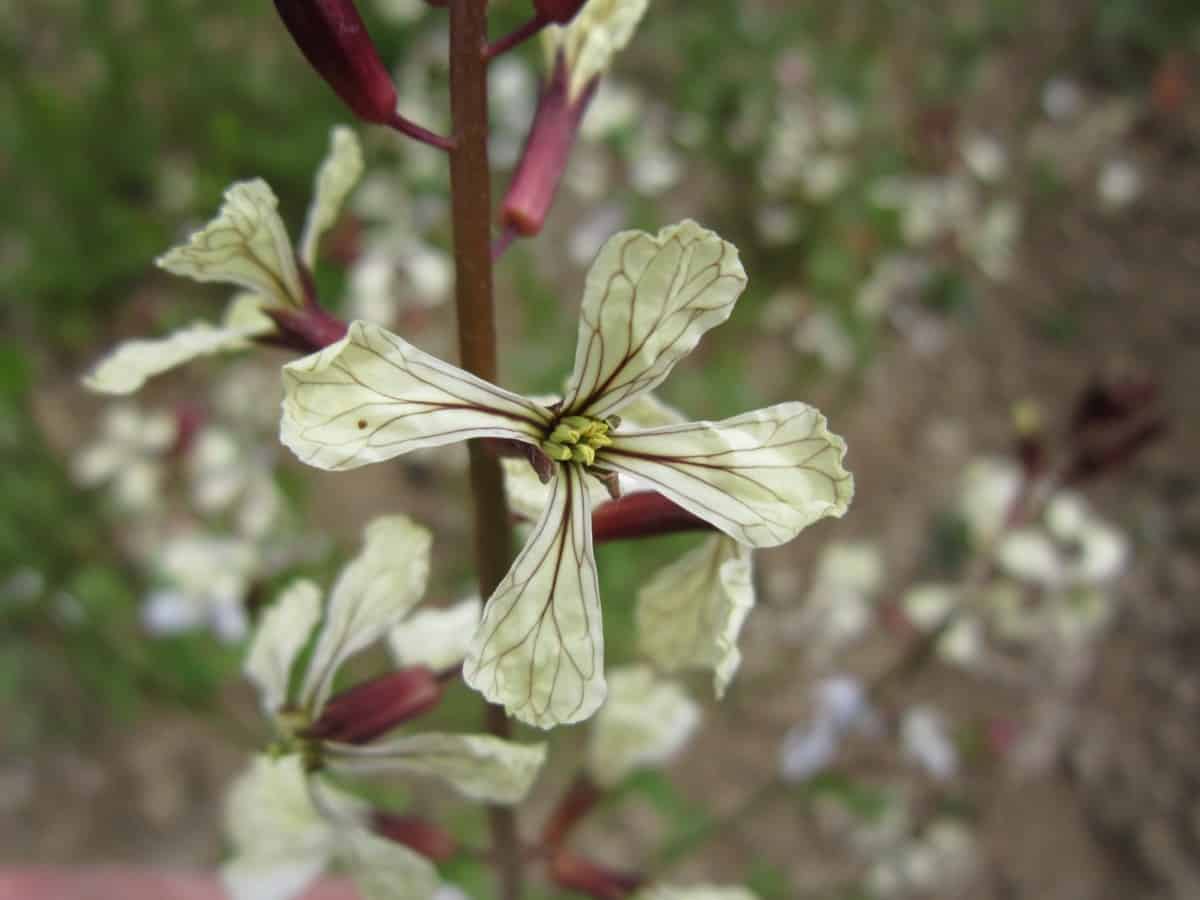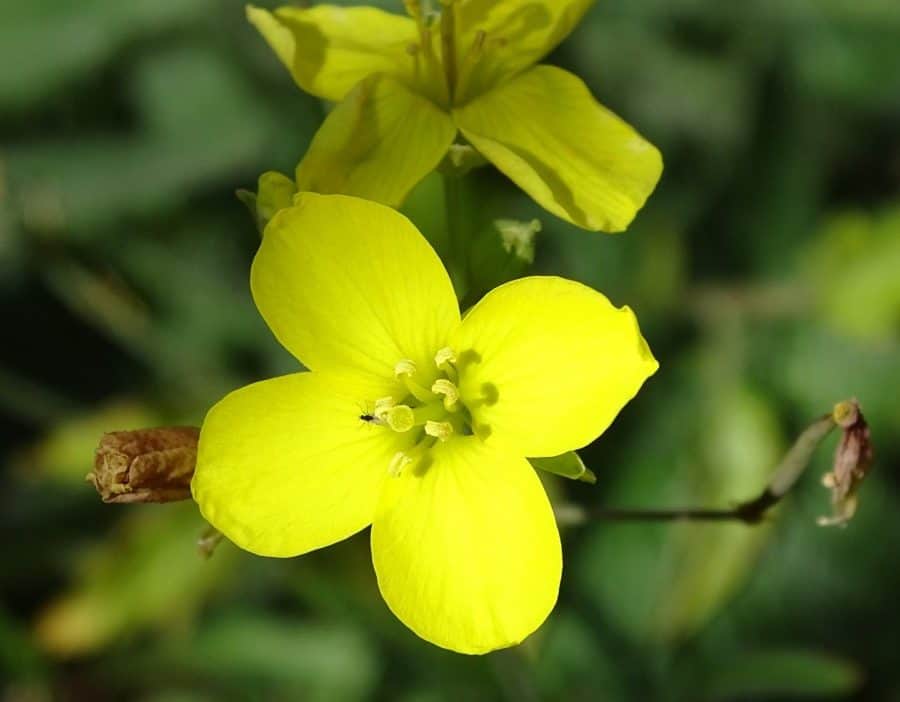Arugula (also known as rocket or roquette) holds a special place in the pantheon of leafy greens, offering a unique flavor that no other can provide. And growing them in your garden, in the ground, container, or even on your windowsill is easy as can be.
But do you have to keep replanting them every year, or will your arugula plants keep coming back? Whether or not arugula will come back depends on several factors (and whether you consider self-reseeding as coming back) which are discussed below. So, make yourself a cup and let’s talk ‘rugula.
On this page:
Does Arugula Come Back Every Year?
Yes, however, it depends on the type of arugula. Standard garden arugula is an annual which won’t grow back the next year, but it can easily reseed itself, sprouting new arugula plants the following year. Wild arugula (Diplotaxis tenuifolia) is a perennial which can survive moderate frosts and grow back every year.
Because of this, you can easily keep a “perennial” arugula bed or container in your garden, letting arugula reseed every year. Arugula seeds can often survive the winter and germinate in the spring when the ground thaws. Arugula itself can survive frosts down to 22°F (-6°C), with some hardier varieties lasting longer. However, even if it survives the winter, common arugula reaches the end of its life cycle after flowering; wild arugula can keep coming back every year while also spreading seeds.
Do I Need to Overwinter My Arugula?
You really don’t need to overwinter arugula in most climates. I’ve had some wild arugula survive winters with temperatures sometimes plunging down to -4°F (-20°C) and self-reseeded garden arugula seeds still sprout the following spring.
However, if you do live somewhere where those temperatures are normal, a few inches of mulch (leaf mulch, straw, or small wood chips) over your arugula bed should offer good protection. Just remember to gently thin out the mulch the following spring. If container gardening, you can even keep it in an unheated garage to overwinter. But if you’re well below the Arctic Circle, you likely won’t need to do it.

Does Arugula Reseed Itself? Does Arugula Spread in the Garden?
Both regular garden arugula and wild arugula can and do reseed themselves, and will spread easily in your garden if you let them flower and go to seed.
Is Arugula an Annual or Perennial?
Common garden arugula is an annual, whereas wild arugula, a completely different species in the same family, is a perennial. Since both are commonly cultivated (and both easily reseed) this has led to confusion.
Despite garden arugula surviving frosts, it’s still an annual, so after it flowers and produces its seeds, the plant will die off. Wild arugula also produces seeds (quite prolifically) but will keep growing and the next spring it will come back, often forming a large rosette, then later growing into a bushy arugula plant.
Differences Between Common Garden Arugula and Wild Arugula
Common garden arugula (Eruca vesicaria, sometimes classified as E. sativa) and wild arugula (Diplotaxis tenuifolia) have similar flavor profiles but grow differently. Garden arugula usually has large-lobed leaves, is an annual, and has white flowers. Wild arugula has more serrated leaves, is a perennial, and has yellow flowers. Wild arugula is also more heat resistant (bolts more slowly).
At first glance, you can often tell the difference between garden arugula and wild arugula varieties. Common arugula has large, lobed leaves, whereas wild arugula has serrated (sometimes extremely serrated) leaves, akin to oak leaves. When they bolt, it’s even easier to identify them, since all garden arugula varieties produce white flowers with four long petals, while wild arugula varieties produce smaller yellow flowers, similar to mustard.
These two types of arugula are different species but both are part of the Brassicaceae family, which is a large family of plants including broccoli, kale, cabbage, radishes, mustards, and horseradish.
If you’ve grown these other Brassicaceae vegetables before, you likely have noticed that a lot of them bolt very easily in hot weather — arugula is no exception. However, wild arugula tends to deal with hot weather better and can resist bolting (producing a flower stalk), often weeks or sometimes more than a month longer than common garden arugula. (Gardener’s note: As I’m writing this, after less than a week of unusually hot weather, almost all my Astro arugula has bolted with many flowers opened up, while most of my Wild Rocket arugula still hasn’t bolted, and only a few just have their first buds.)


What Happens When Arugula Bolts?
Arugula bolts in hot weather, regardless of the time of year. When arugula bolts, you will notice new leaves growing smaller and being more spaced apart as the plant starts growing more vertically, and if you look carefully, you will see the tiny buds forming on the tip.
You will often notice on garden arugula varieties that the stem and even the leaves will start getting hairy, the stem will get tougher, and the leaves will get spicier and also more bitter.
When wild arugula bolts, the new leaves also become smaller. However, wild arugula doesn’t get nearly as bitter when it bolts, and for people who love the taste of arugula, it tastes almost as good after bolting. The leaves also remain tender and don’t get hairy.
The buds, flowers, and even the young, tender seed pods of all arugula varieties are edible, too.
Which Is Better: Common Garden Arugula or Wild Arugula?
It might seem like wild arugula is better in every way — it’s more bolt/heat resistant and it’s a perennial. However, there are some drawbacks to wild arugula.
- Wild arugula has a slightly different flavor profile than common garden arugula. Depending on the growing conditions, it can be a bit spicier than the arugula you’re used to. However, the flavor doesn’t change as much after bolting.
- Wild arugula tends to have smaller leaves.
- Garden arugula germinates much faster and grows faster than wild arugula, reaching maturity sometimes weeks earlier. Some garden arugula varieties, like Astro, can reach maturity within 30 days (sooner for baby arugula) while the super bolt-resistant Wild Rocket will take 50 days, not including the extra time for germination.
So, if you prefer large, luscious arugula leaves and quick harvests, grow garden arugula. If you don’t mind waiting longer before you can harvest and you like the flavor of wild arugula, grow that. Or, if you’re an arugula aficionado, do what I do and grow both!
Related Questions About Growing Arugula
How Do You Harvest Arugula So It Grows Back?
It’s recommended to use the cut-and-come-again method of harvesting leafy greens to harvest arugula so it grows back. This involves harvesting individual leaves, starting with the larger, lower leaves, while leaving the central young leaves on the growing tip.
You can use another common method of harvesting arugula which involves bunching the leaves together and cutting across the plant (sort of like mowing the top of the plant), but you still need to avoid cutting the central growing tip if you want it to grow back.
Can You Eat Arugula After It Bolts (Flowers)?
Arugula is perfectly safe to eat after it bolts, and the flowers themselves are even edible. However, arugula gets a stronger, spicier flavor after bolting, and garden arugula varieties also tend to get hairy and tough. Wild arugula gets spicier and will produce smaller leaves after bolting, but is otherwise good to eat.
How to Harvest Bolted Arugula
After bolting, you can still cut individual arugula leaves, similar to the cut-and-come-again method of harvesting for other salad greens. If you notice your arugula stem and leaves are getting hairy and tough, you can also cut off the petioles (the little stalk attaching a leaf to the stem). You can also harvest the buds, flowers, and even the young, green seed pods.
Bolted arugula is still edible, but it will have a stronger spicy flavor, it will be more bitter, and the stems and petioles may be tougher. After bolting, young leaves will generally taste milder than older leaves.
Can You Grow Arugula in the Summer?
You can grow arugula in the summer, but unless you are growing a variety of wild arugula, you will need to take extra steps to extend your growing season, such as using shade cloth or planting in areas with partial shade.
Growing arugula in the summer is similar to growing other cool-weather leafy greens in the summer (like lettuce).
- Plant your arugula in partial shade. Planting along an east- or west-facing wall, between larger vegetables, or even on the north side of shrub or a row of vegetables which will shade out your arugula during the hottest part of the day.
- Plant arugula in containers. One of the benefits of container gardening is that you can move your containers around to maximize sunlight; but in this case, you want to keep your containers in a partially shaded area. You can also move your container arugula under the shade during heat waves to give your arugula some relief from the sun.
- Grow arugula under shade cloth. Shade cloth is a type of woven fabric which blocks out a certain percentage of sunlight, anywhere from 20% to 95%. This simulates partial shade and protects your arugula from extreme heat. For arugula, anywhere from 30-60% shade cloth should suffice.
- Grow heat-tolerant varieties of arugula. Wild varieties can grow all season long, even after bolting, while common garden varieties are better-suited for spring and fall gardening. Astro and especially Slow Bolt are relatively heat-tolerant garden varieties, while Wild Arugula/Rocket (sometimes sold as Wild Italian Arugula/Rocket) is the most heat-tolerant wild variety I’ve grown.
